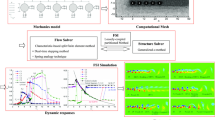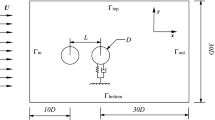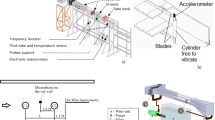Abstract
Wake-induced vibration (WIV) is a special case of vortex induced vibration, which occurs in tandem cylinders. The downstream cylinder moving across the wake from the upstream cylinder oscillates under the alternating lift force. In a previous study by the authors, the downstream cylinder was pivoted to the upstream cylinder, thereby develo** a swinging motion, which was termed as the pendulum system of tandem cylinders (PSTC). They found that the PSTC exhibits higher energy conversion efficiency than the conventional translational system of tandem cylinders (TSTC). In this study, the changes in the WIV characteristics were investigated experimentally with varying geometry conditions, such as the shape of the upstream cylinder and the spacing between two cylinders. Nine cases were tested by combining three upstream cylinder shapes (i.e., circle, square, and diamond) and three cylinder spacing values (S/D = 3, 4, 5). For each case, the reduced velocity (U* = V/Df0) was varied in the 0 ≤ U* ≤ 50 range. In addition to the mechanical response measurement of the downstream cylinder, the electrical power generated by the swinging motion was also measured. Results show that the maximum response was obtained for the circular upstream cylinder and S/D = 3, which is inconsistent with that obtained in the previous study.
Similar content being viewed by others
Abbreviations
- c :
-
Dam** coefficient
- D :
-
Diameter of cylinder
- f 0 :
-
Natural frequency
- I :
-
Moment of inertia
- I* :
-
Moment of inertia ratio
- k :
-
Torsional stiffness
- M :
-
Mass of cylinder
- m*:
-
Mass ratio
- P mech :
-
Mechanical power
- P elec :
-
Electrical power
- Re :
-
Reynolds number
- S :
-
Cylinder spacing
- V :
-
Flow speed
- U*:
-
Reduced velocity
- η mech :
-
Mechanical energy conversion efficiency
- v :
-
Kinematic viscosity
- ζ :
-
Dam** factor
References
A. Khalak and C. H. K. Williamson, Dynamics of a hydroelastic cylinder with very low mass and dam**, Journal of Fluids and Structures, 10 (1996) 455–472.
A. Khalak and C. H. K. Williamson, Motions, forces and mode transitions in vortex-induced vibrations at low mass-dam**, Journal of Fluids and Structures, 13 (1999) 813–851.
N. Jauvtis and C. H. K. Williamson, The effect of two degrees of freedom on vortex-induced vibration at low mass and dam**, Journal of Fluid Mechanics, 509 (2004) 23–62.
G. R. S. Assi, P. W. Bearman and J. R. Meneghini, On the wake-induced vibration of tandem circular cylinders: the vortex interaction excitation mechanism, Journal of Fluid Mechanics, 661 (2010) 265–401.
G. R. S. Assi, P. W. Bearman, B. S. Carmo, J. R. Meneghini, S. J. Sherwin and R. H. J. Willden, The role of wake stiffness on the wake-induced vibration of the downstream cylinder of a tandem pair, Journal of Fluid Mechanics, 718 (2013) 210–245.
M. M. Bernitsas, K. Raghavan, Y. Ben-Simon and E. M. H. Garcia, VIVACE (Vortex Induced Vibration Aquatic Clean Energy): a new concept in generation of clean and renewable energy from fluid flow, Journal of Offshore Mechanics and Arctic Engineering, 130 (2008) 041101.
E. S. Kim, Synergy of multiple cylinders in flow induced motion for hydrokinetic energy harnessing, Ph.D. Thesis, University of Michigan (2013).
E. S. Kim, M. M. Bernitsas and R. A. Kumar, Multicylinder flow-induced motions: enhancement by passive turbulence control at 28000 < Re < 120000, Journal of Offshore Mechanics and Arctic Engineering, 135 (2013) 021802.
E. S. Kim and M. M. Bernitsas, Performance prediction of horizontal hydrokinetic energy converter using multiple-cylinder synergy in flow induced motion, Applied Energy, 170 (2016) 92–100.
H. Sun, E. S. Kim, M. P. Bernitsas and M. M. Bernitsas, Virtual spring-dam** system for flow-induced motion experiments, Journal of Offshore Mechanics and Arctic Engineering, 137 (2015) 061801.
C. Ma, H. Sun, G. Nowakowski, E. Mauer and M. M. Bernitsas, Nonlinear piecewise restoring force in hydrokinetic power conversion using flow induced motions of single cylinder, Ocean Engineering, 128 (2016) 1–12.
G. Manfrida, M. Rinchi and G. Soldi, Dynamic model of a vortex-induced energy converter, Journal of Energy Resources Technology, 138 (2016) 062002.
C. M. Lee, K-J. Paik, E. S. Kim and I. Lee, A fluid-structure interaction simulation on the wake-induced vibration of tandem cylinders with pivoted rotational motion, Physics of Fluids, 33 (2021) 045107.
C. M. Lee, W.-Y. Jung, E. S. Kim, K.-J. Paik, S.-B. Suh and I. Lee, Experimental investigation of the wake-induced pendulum motion of tandem cylinders, International Journal of Naval Architecture and Ocean Engineering, 14 (2022) 100453.
M. Zhao, L. Cheng and T. Zhou, Numerical simulation of vortex-induced vibration of a square cylinder at a low reynolds number, Physics of Fluids, 25 (2013) 023603.
J. Zhao, J. S. Leontini, D. L. Jacono and J. Sheridan, Fluid-structure interaction of a square cylinder at different angles of attack, Journal of Fluid Mechanics, 747 (2014) 688–721.
Acknowledgments
This work was supported by the National Research Foundation of Korea (NRF) grant funded by the Ministry of Science and ICT of Korea (No. 2022R1A2C2010821) and by the Korea Institute of Energy Technology Evaluation and Planning (KETEP) and the Ministry of Trade, Industry & Energy (MOTIE) of the Republic of Korea (20224000000090), to which deep gratitude is expressed.
Author information
Authors and Affiliations
Corresponding author
Additional information
Young** Jang is a Ph.D. student of the department of naval architecture and ocean engineering, Pusan National University, Busan, Korea. He received his master’s degree in the department of electrical engineering from University of Ulsan, Ulsan, Korea. He works for Hyundai Maritime Research Institute, Hyundai Heavy Industries Co. Ltd., Ulsan, Korea. His research interests include renewable energy using fluid force, test facility automation, and digital transformation.
Hyunjun Kim is a Ph.D. student at the School of Naval Architecture and Ocean Engineering, Pusan National University, Busan, Korea. He received his master’s degree from Pusan National University. His research interests include flow-induced vibration, hull form optimization and flow control.
Cheol-Min Lee works at Samsung Heavy Industries, Daejeon, Korea. He received his Ph.D. from Pusan National University, Busan, Korea. His research interests include wake-induced vibration, and resistance and propulsion for the ship.
Sung-Bu Suh is a Professor of Dong-Eui University, Busan, Korea. He received his Ph.D. in Naval Architecture and Ocean Engineering from Pusan National University. His research interests include marine hydrodynamics, propulsion and leisure equipment.
Inwon Lee is a Professor in the Dept. of Naval Architecture and Ocean Engineering at Pusan National Univ. He received his Ph.D. from the Mechanical Engineering Department at KAIST in 2000. After joining the faculty of PNU in 2003, he has been working in the field of ship energy saving through various drag reduction techniques such as low frictional coating, air lubrication, hull form optimization and appendages. His research interests also include flow control and drag reduction of turbulent flows, quantitative flow visualization using PIV, experimental fluid mechanics in towing tank and wind tunnel.
Rights and permissions
About this article
Cite this article
Jang, Y., Kim, H., Lee, CM. et al. Effect of the geometric configuration of the pendulum system of tandem cylinders (PSTC) on the hydrokinetic energy conversion efficiency of wake-induced vibration. J Mech Sci Technol 37, 779–791 (2023). https://doi.org/10.1007/s12206-023-0121-6
Received:
Revised:
Accepted:
Published:
Issue Date:
DOI: https://doi.org/10.1007/s12206-023-0121-6




